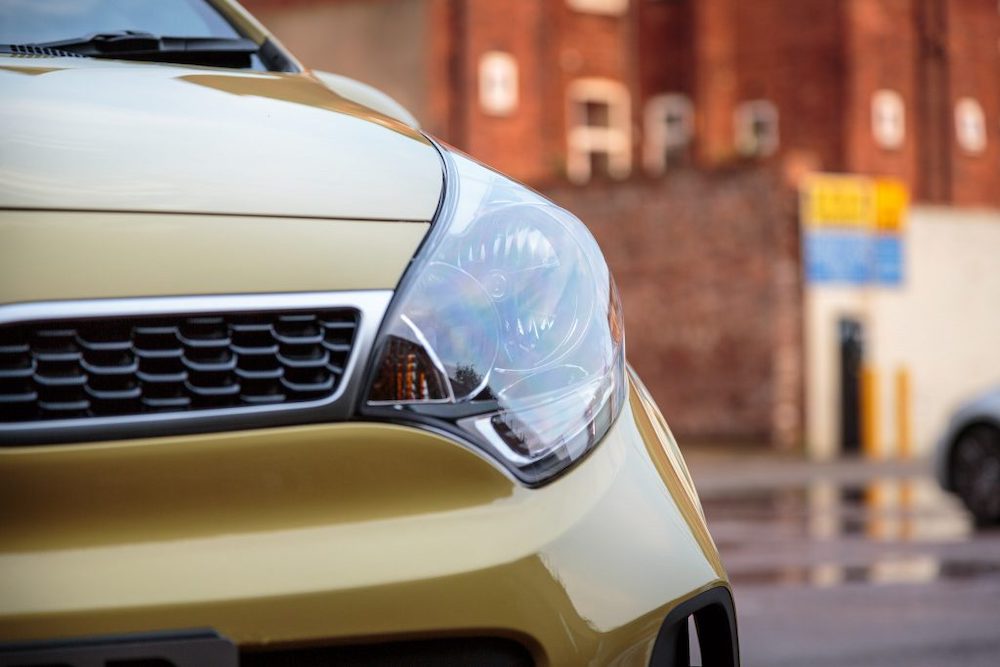How Do Headlights Work?
Before getting into the specifics, let’s start with the basics. Each car headlight has two light beams: the high beam and the low beam. They both distribute light differently. When the low beams are switched on, the light is positioned forward and towards the ground to light up the road without dazzling oncoming traffic. The light emitted has a lower intensity than the high beam and reaches a shorter distance. The high beams are designed to light up a larger area for greater visibility. They should normally only be used on unlit stretches of road when it is dark. It’s important to turn them off when meeting oncoming traffic, following another vehicle, for example, so that the vision of other road users is not affected.
Headlights operate differently and with varying efficiency depending on the type of bulb:
- Halogen bulbs
These are still arguably the most common bulbs on the road today as they are cheap to produce and easy to replace. The components typically use gases such as nitrogen and argon and a tungsten filament to generate light. The tungsten is heated up by the electricity and consequently emits a visible light. As the tungsten starts to evaporate, the gas prevents it from sticking to the glass, and instead redeposits some of the particles onto the filament to make it last longer.
There are several types of halogen bulbs, some with a single filament and others with a dual filament. For example, an H4 bulb has two filaments, one for low beam and one for high beam, whereas a H11 bulb is a single filament bulb with an L-shaped socket. Single filament bulbs, such as the HELLA 8GH 008 358-121 12V bulb, are also commonly used for the fog lights. This Hella component is ECE certified with a power rating of 55W. It’s suitable for a large number of popular vehicle models from top brands, including BMW, Audi, Ford, Honda, and Mitsubishi.
- Xenon
Xenon high intensity discharge (HID) headlights use xenon gas and rare metals to generate a bright white light. Instead of a filament, the bulbs use electrodes to charge the gas. They are up to three times brighter than halogen bulbs and consume less energy, but are more expensive to replace. The higher price tag is partly due to the rare metals required to produce them. However, they also take longer to reach full brightness.
- LED
These are currently among the most energy-efficient headlight lamps available. The light emitting diodes are much faster and brighter than halogen headlights. They also often last longer than the other two types, but are considerably more expensive than standard lamps.

When Should You Change The Headlights?
Some headlight bulbs last longer than others, so there isn’t necessarily a set replacement interval which all car owners should adhere to. The average halogen lamp lasts between 500 and 1,000 hours, whereas some xenon components can last up to 10,000 hours. LED components have an even longer service life, lasting up to 30,000 hours.
If the bulbs have blown or are no longer working as they should be, it’s important to get it replaced promptly as it is an offence to drive without functioning headlights. It is recommended to replace them in pairs (i.e. both high beam bulbs) to keep the lighting consistent and save you time in the future.
How To Change The Headlights
For detailed instructions, refer to your vehicle owner’s manual.
1. Identify the faulty bulb
This is fairly straightforward when there is only one bulb for both beams. However, it is not always easy to detect which bulb is gone from inside the vehicle.
2. Find the right replacement
Simply check what’s written on the bulb or inside the user’s manual to find the right replacement, or enter your vehicle’s details online for compatible products.
3. Open up the bonnet and locate the faulty light
Locate the bulb and remove the light cover to access it.
4. Disconnect it from the vehicle’s electrical system
You’ll normally find three wires attached to the base of the component. It may also be held in place by a clip, catch or screw cap. Disconnect the wires and detach the bulb.
5. Install the new part and secure the cover
Attention:
- Wear clean gloves to avoid getting the surface of the bulb dirty or oily
- Make sure it is installed in the correct position and that the beam is reflected properly
- Make sure the lightbulb cover is firmly secured to protect it against moisture, etc.

